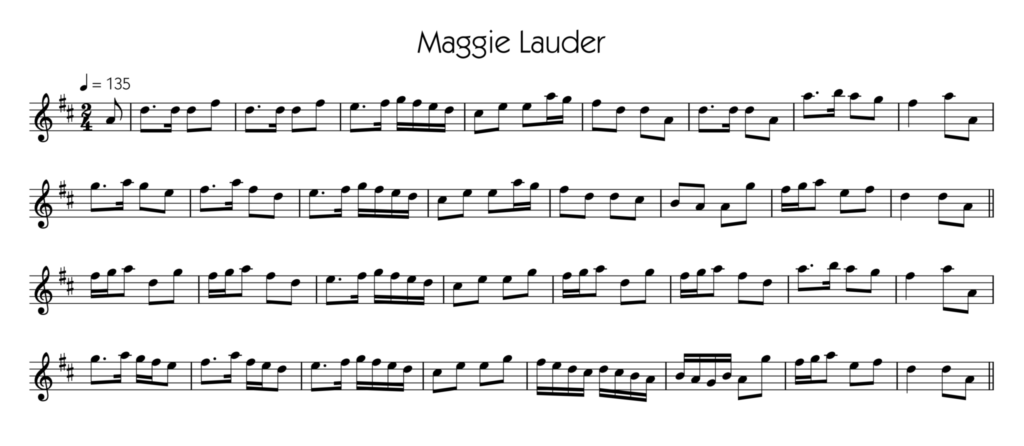As The Traditional Tune Archive points out, “The melody “Maggie Lauder” (and its many variant spellings) has had astonishing longevity from its first publications in the late 17th and early 18th centuries, and has been an adaptable piece of music, rendered in various forms depending on context and need, including (and probably originally) a song air, polka, schottische, country dance, and others, as well as being the basis for numerous variation sets (particularly in piping repertoire).”

This is one of those tunes that I’ve known in my head for many years but never fully learned to play until relatively recently.
Matt Seattle has published a thorough study of the tune, beginning with its origins as a song melody and including some of the many settings that have appeared for various instruments throughout its history. The article is available on the Lowland and Border Pipers’ Society Website.
Many settings reach beyond the pipe scale but I think the first pipe setting I saw was in Gordon Mooney’s book ‘The Choicest Bagpipe Music From The Scottish Borders And Lowlands’ which I purchased soon after acquiring my pipes in the early 90s. This book is well worth seeking out and has a great selection of tunes.
I suppose my setting is an amalgamation of all the versions I’ve heard and played through over the years. I’ve notated the high B in penultimate bar of each part but if your pipes can’t play a high B then you can replace it with something else as I have done in the video. The parts are sometimes repeated but as I play it in the middle of a set of two 32 bar tunes, Jack Lattin and Stumpie, I’ve notated and played it here without repeats.
Below is the tune in ABC notation. ABC is a great way to share simple, single staff notation and is popular amongst traditional musicians. You can learn about ABC notation here and I recommend EasyABC or Michael Eskin’s ABC Transcription Tools to convert the tunes into standard notation, for editing and playback.
X:1
T:Maggie Lauder
M:2/4
L:1/8
Q:1/4=135
K:D
A| d>d df | d>d df | e>f g/2f/2e/2d/2 | ce ea/2g/2 | fd dA | d>d dA | a>b ag | f2 aA |
g>a ge | f>a fd| e>f g/2f/2e/2d/2 | ce ea/2g/2 | fd dc | BA Ag | f/2g/2a ef | d2 dA ||
f/2g/2a dg | f/2g/2a fd | e>f g/2f/2e/2d/2 | ce eg | f/2g/2a dg | f/2g/2a fd | a>b ag | f2 aA |
g>a g/2f/2e | f>a f/2e/2d | e>f g/2f/2e/2d/2 | ce eg | f/2e/2d/2c/2 d/2c/2B/2A/2 | B/2A/2G/2B/2 Ag | f/2g/2a ef | d2 dA ||
Leave a Reply